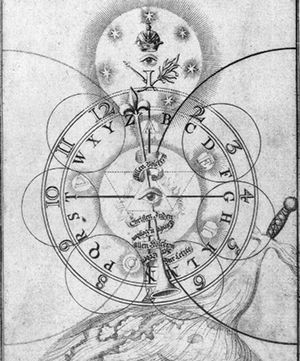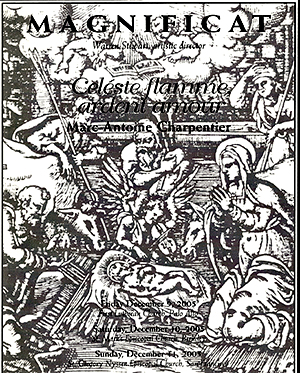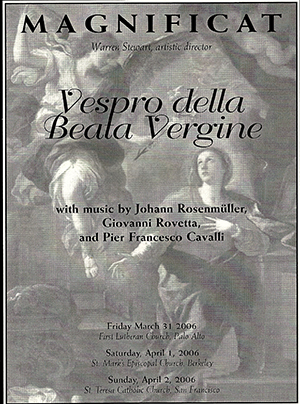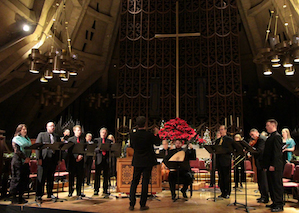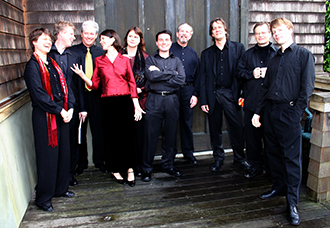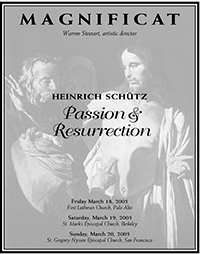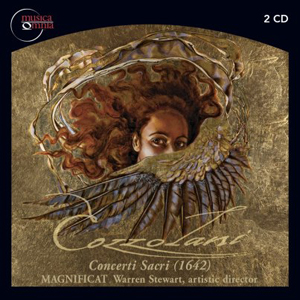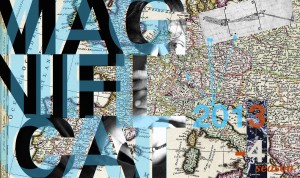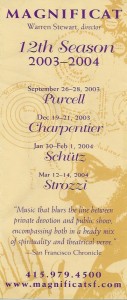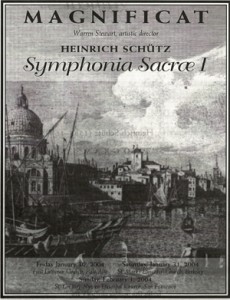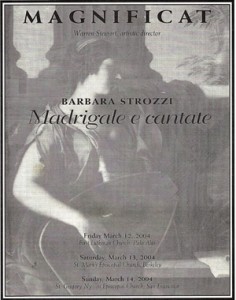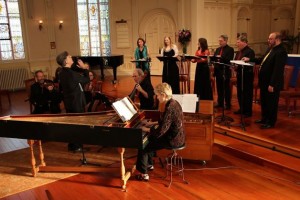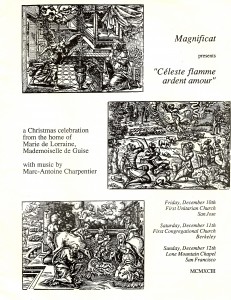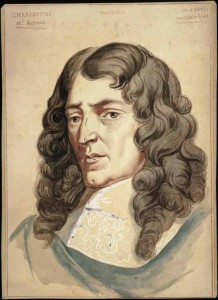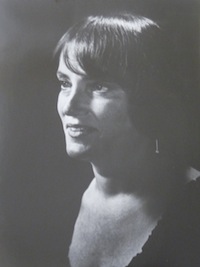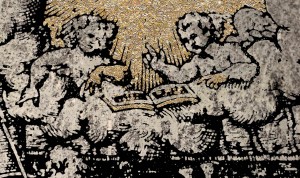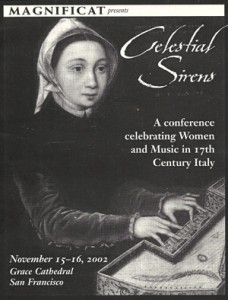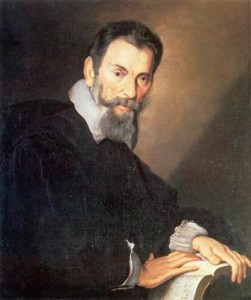Curiose e Moderne Invenzioni – Magnificat Performs Monteverdi and Schütz
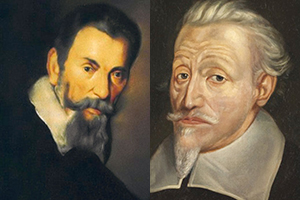 “Staying in Venice as the guest of old friends, I learned that the long unchanged art of composition had changed somewhat: the ancient rhythms were partly set aside to tickle the ears of today with fresh devices.”
“Staying in Venice as the guest of old friends, I learned that the long unchanged art of composition had changed somewhat: the ancient rhythms were partly set aside to tickle the ears of today with fresh devices.”
Thus Heinrich Schütz described his experiences during his second trip to the Most Serene Republic in a letter to a friend upon his return to Dresden. Our program this evening explores his visit, one of the most consequential musical encounters of the seventeenth century. It focuses on a meeting that must have taken place between two of the towering figures of music in the first half of the century: Schütz and Claudio Monteverdi – a meeting that embodies the migration of style from Italy over the Alps so characteristic of the early Baroque.
Earlier in his life, Schütz had spent four years in Venice as a student of Giovanni Gabrieli, his studies ending with the old master’s death in the summer of 1612. Schütz returned to Saxony a few months later, thus missing Monteverdi’s arrival in Venice by less than a year. Shortly after his return, Schütz was engaged as Kapellmeister to the Elector of Saxony in Dresden – among the most prestigious positions for a musician in Germany, a position he retained for the rest of his very long life.
In 1617 Schütz composed and directed the music for the extensive festivities celebrating the centenary of the Reformation, leading a large ensemble of singers and instrumentalists. Much of this music was published in Schütz’s Psalmen Davids in 1619 and was written in the robust polychoral style of his teacher. He continued to enjoy a happy and productive life in Dresden until a series of personal tragedies in the mid 1620s were followed by Saxony’s disastrous decision to enter what we now call the Thirty Years War in 1627. Funds were quickly diverted from music and the arts to the military effort and already in 1628 the Electoral Music had been drastically reduced and Schütz began a period of more than a decade in which he was often away from Dresden. He had petitioned his employer several times for permission to travel to Venice and when it was finally granted in the summer of 1628, he quickly made preparations for the journey, arriving in Italy in early fall and staying for almost a year.
While there is no direct documentation of a meeting between Schütz and Monteverdi during his second visit, it is inconceivable that they were not in contact. As the music directors of two of the greatest musical establishments in Europe, they would surely have met and perhaps even performed together and the spirit of Monteverdi’s “new music” that Schütz heard in Venice remained an inspiration for the remainder of his life.
Two works on our program display the influence of Monteverdi on Schütz quite literally: the madrigal Chiome d’oro, set to German text by Schütz in the 1640s and especially the sacred motet Es steh Gott auf, included in his second set of Symphoniæ Sacræ. This delightful motet is a parody of madrigals by Monteverdi found in his Scherzi musicali of 1632: Armato il cor and Zefiro torna. Schütz wrote in the preface that he “in some small way followed” these two works, but added that no one should believe him to have been only “so lazy as to decorate his work with others’ feathers.”
While our program is built around several works by the two masters, the music of other composers that Schütz may have heard during his visit is represented as well. Most significantly for Schütz was most likely Alessandro Grandi, whose superbly crafted motets and concertato madrigals are most clearly reflected in the style Schütz developed after his visit to Venice. Grandi had been Monteverdi’s assistant at San Marco for over a decade before moving to Bergamo to become maestro di capella at Santa Maria Maggiore, a position that not only paid him very well but also gave him the opportunity to write music for larger forces. Tragically, his life was cut short at the peek of his career by the plague that ravaged Northern Italy in 1630.
What little is known of the instrumentalist and composer Dario Castello is drawn primarily from the title pages of his publications, which identify him as a musician at San Marco and the leader of an ensemble of winds. His two surviving collections of sonatas feature extraordinarily virtuosic writing, suggest that he was most likely a highly skilled performer. The large number of reprints of both books is an indication of the popularity and wide diffusion of Castello’s works throughout Europe.
By contrast, we know considerably more about Castello’s sometimes colleague at San Marco, Biagio Marini. During Schütz’s visit to Venice, Marini, already well established as one of the first virtuoso violinists in Europe, published his eighth book of compositions, subtitled “Curiose e Moderne Invenzioni.” Born in Brescia in 1594, Marini had been appointed as a violinist at San Marco in 1615 where he worked directly with Monteverdi and Grandi. By 1620 he had begun what would be a peripatetic career that would see him serve as instrumentalist and music director in several Italian cities and in courts as far north as Düsseldorf and Neuberg. A prolific composer, by the time of his death in 1663 he had published over 20 collections of music, including sacred and secular vocal music as well as music for violin and instrumental ensembles.
Carlo Farina was a violin virtuoso born in Mantua during Monteverdi’s tenure there and may have studied with Salamone Rossi. In 1625 he was appointed concertmaster of Electoral Court of Saxony where he worked closely with Schütz and published his two collections of violin music. With the deterioration of the situation in Saxony, Farina returned to Italy in 1628, working for a time in Parma and later at Lucca. In fact, one of Schütz’s assignments on his trip to Venice was to secure the services of a violinist to replace Farina and indeed he returned to Dresden with the highly respected violinist Francesco Castelli, also from Mantua. Farina crossed the Alps again in the 1630s to work in Danzig and then Vienna, where he died in 1638.
Our program includes two toccatas – one for theorbo and one for harpsichord – that further reflect the integration of Italianate and Transalpine styles. The Bolognese lutenist Alessandro Piccinini was a contemporary of Monteverdi, who worked in Ferrara and Bologna. In the first of his publications of music for the lute, he makes the plausible claim to have invented the archlute in the 1590s. Whatever the veracity of his claim, there is little doubt that Piccinini was the finest lutenist of his generation.
Like Schütz, Johan Jacob Froberger travelled to Italy to study. Born in Stuttgart, Froberger had already been employed as an organist in Vienna when he first travelled to Rome to study with Frescobaldi from 1637 to 1641. After spending six years back in Vienna, he returned to Rome, this time working with the polymath Athanasius Kircher and possibly Iacomo Carissimi. After leaving Rome he travelled extensively, performing in many courts across Europe. In 1650 he was in Dresden where he likely collaborated with Schütz and Christoph Bernhard. Froberger’s compositions, almost entirely for keyboard, exerted a considerable influence on harpsichord and organ music in the second half of the century, not only in his native Germany but also in France. His blend of Italian exuberance and expressivity with northern counterpoint and chromaticism echoes in the works of Buxtehude, Böhm, Couperin and Bach.
Magnificat is grateful to the San Jose Chamber Music Society for the invitation to return to perform on a series on which we first appeared in 1991. That program also featured music of Monteverdi and Schütz and served as a catalyst for our own annual concert series, which began the next year.
